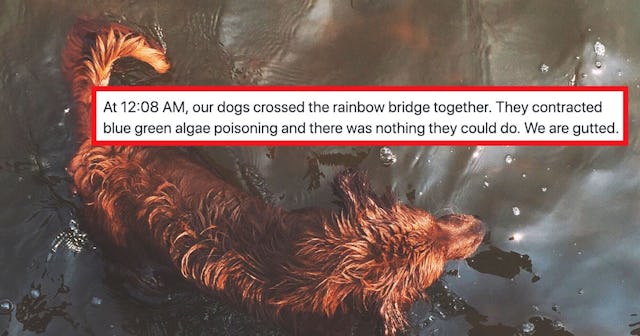Dogs Were Taken To Ponds To Play And Within Hours Were All Dead From Toxic Algae

Dog owners are now warning others of the danger that ponds hold toxic algae that can kill your pet
Imagine this: It’s a hot summer day, so you take your pup to a local pond or lake for a swim to cool off. But within hours of leaving the water, your dog is having a seizure, showing signs of motor skill loss, neurological damage, or liver damage. This is the heartbreaking reality that several dog owners have faced this summer after their dogs encountered toxic algae in the water and died. Now, they’re all trying to warn other dog owners of the danger.
Melissa Martin and Denise Mintz lost their dogs after letting them play together in a pond in Wilmington, North Carolina. The dogs, West Highland terriers Abby and Izzy and doodle mix Harpo, played in the water and rolled in the mud. But soon after leaving the pond, all three dogs started showing alarming signs of serious illness. They were rushed to an emergency vet, but within hours, all three of them had died.
“They contracted blue green algae poisoning and there was nothing they could do,” Martin wrote in a heartbreaking viral post on Facebook. “We are gutted. I wish I could do today over. I would give anything to have one more day with them.”
Morgan Fleming had an alarmingly similar story out of Marietta, Georgia. She and her husband took their border collie, Arya, to a local lake for a swim on a hot day, and in the car on the way home, she started to get sick. They too rushed her to the vet, but they were told it was too late. Toxic algae exposure at the lake had made her too sick to save.
Those dogs aren’t the only ones.
Toxic algae is a very real danger for pets — and people — in the summer. The most common type of toxic algae, often called blue-green algae because of its color, most commonly affects warm, standing water — so, those inland lakes and ponds that look so appealing to water-loving dogs in the hot summer months. The symptoms for dogs include too much salivation, weakness, staggered walking, difficulty breathing, convulsions, and as these grieving pet owners found out, even death.
The Centers for Disease Control and Prevention warns that animals are particularly susceptible, since they’re more likely to drink from contaminated bodies of water or lick toxic algae off their fur after they’ve been exposed. The safest course of action, they say, is to learn to recognize what algae blooms look like in water, and then avoid water altogether if any algae is present, since it’s impossible to tell just by looking at it whether an algae bloom is made up of toxic algae. A 2014 survey cited by the CDC noted that 38 states and D.C. have harmful algal blooms “present every year in some of their lakes or other fresh water bodies.” All coastal states have the blooms as well, including Alaska and Hawaii.
Just to be safe, it might be a good idea to stick to the pool with your dogs this summer.
This article was originally published on